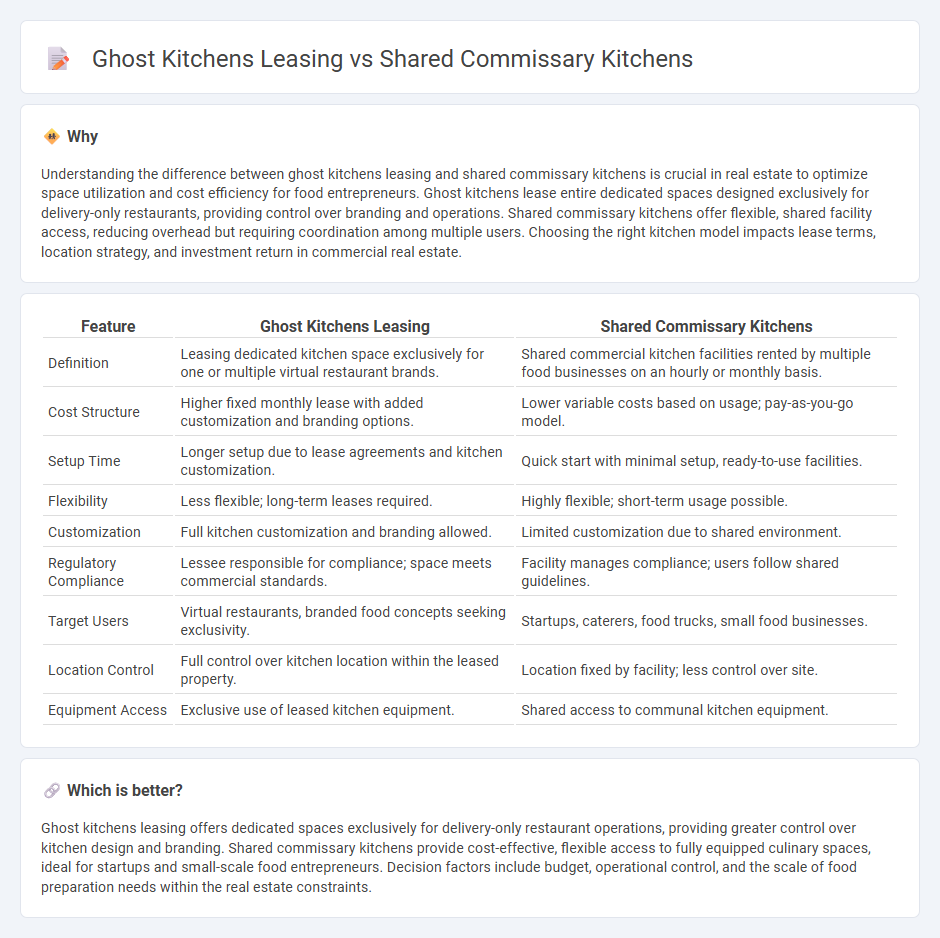
Ghost kitchens leasing offers restaurateurs dedicated, fully equipped spaces optimized for delivery-only operations, ensuring greater control over brand and menu customization. Shared commissary kitchens provide cost-effective, communal cooking environments with flexible terms but limited exclusivity and potential scheduling constraints. Explore the key differences to determine which kitchen leasing model best suits your food business growth strategy.
Why it is important
Understanding the difference between ghost kitchens leasing and shared commissary kitchens is crucial in real estate to optimize space utilization and cost efficiency for food entrepreneurs. Ghost kitchens lease entire dedicated spaces designed exclusively for delivery-only restaurants, providing control over branding and operations. Shared commissary kitchens offer flexible, shared facility access, reducing overhead but requiring coordination among multiple users. Choosing the right kitchen model impacts lease terms, location strategy, and investment return in commercial real estate.
Comparison Table
| Feature | Ghost Kitchens Leasing | Shared Commissary Kitchens |
|---|---|---|
| Definition | Leasing dedicated kitchen space exclusively for one or multiple virtual restaurant brands. | Shared commercial kitchen facilities rented by multiple food businesses on an hourly or monthly basis. |
| Cost Structure | Higher fixed monthly lease with added customization and branding options. | Lower variable costs based on usage; pay-as-you-go model. |
| Setup Time | Longer setup due to lease agreements and kitchen customization. | Quick start with minimal setup, ready-to-use facilities. |
| Flexibility | Less flexible; long-term leases required. | Highly flexible; short-term usage possible. |
| Customization | Full kitchen customization and branding allowed. | Limited customization due to shared environment. |
| Regulatory Compliance | Lessee responsible for compliance; space meets commercial standards. | Facility manages compliance; users follow shared guidelines. |
| Target Users | Virtual restaurants, branded food concepts seeking exclusivity. | Startups, caterers, food trucks, small food businesses. |
| Location Control | Full control over kitchen location within the leased property. | Location fixed by facility; less control over site. |
| Equipment Access | Exclusive use of leased kitchen equipment. | Shared access to communal kitchen equipment. |
Which is better?
Ghost kitchens leasing offers dedicated spaces exclusively for delivery-only restaurant operations, providing greater control over kitchen design and branding. Shared commissary kitchens provide cost-effective, flexible access to fully equipped culinary spaces, ideal for startups and small-scale food entrepreneurs. Decision factors include budget, operational control, and the scale of food preparation needs within the real estate constraints.
Connection
Ghost kitchens leverage leased commercial real estate spaces typically designed as shared commissary kitchens to minimize overhead costs and optimize operational efficiency. These commissary kitchens provide essential infrastructure, including food preparation areas, storage, and equipment, enabling multiple food businesses to operate under one roof without the need for full-scale restaurant leases. The synergy between ghost kitchens and communal kitchen leasing models drives a flexible, scalable real estate solution that supports the booming delivery and food service industry.
Key Terms
Licensing Agreements
Shared commissary kitchens often feature flexible licensing agreements that allow multiple food entrepreneurs to use commercial kitchen space without the long-term commitments typically required by ghost kitchens. Ghost kitchens leasing usually involves exclusive licenses paired with advanced technology integration and brand-specific operational control, optimizing delivery-only food experiences. Explore the nuances of licensing agreements to determine which kitchen model best suits your business needs.
Zoning Regulations
Zoning regulations play a crucial role in differentiating shared commissary kitchens from ghost kitchens, as each type must comply with local land use laws tailored for commercial food production. Shared commissary kitchens often fall under regulations designed for multi-tenant food preparation facilities, whereas ghost kitchens must navigate zoning laws suited for delivery-only or no-customer establishments. Learn more about how zoning impacts operational decisions and leasing options in these kitchen models.
Revenue-Sharing Models
Revenue-sharing models in shared commissary kitchens often involve tenants paying a percentage of their sales, aligning the kitchen owner's income with the success of each food business. Ghost kitchens leasing differs by usually charging fixed rent fees, which provide predictable costs for operators but less direct profit involvement for landlords. Explore how these revenue-sharing strategies impact operational flexibility and profitability in food industry ventures.
Source and External Links
Commissary Kitchen - A shared facility rented by multiple food businesses for preparation and storage, offering lower upfront costs and pre-certified health compliance.
What is a Commissary Kitchen? - Provides economical access to commercial-grade equipment and space for various food businesses, such as bakers and caterers.
Shared-use Kitchens: The Definitive Guide - Offers a professional-grade cooking environment ideal for small-scale producers, startups, and nonprofits, promoting collaboration and cost efficiency.
 dowidth.com
dowidth.com